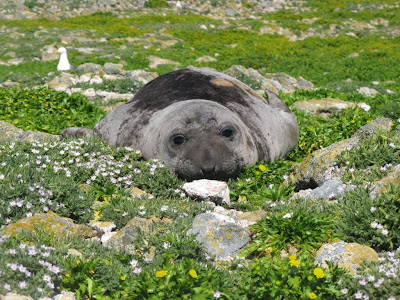 With ocean swells constantly pounding the island day and night, all year long, the intertidal zone on the Farallones is a harsh environment indeed. Nonetheless, a variety of tenacious plants and animals survive in this zone, and they are revealed during low tides. Only then can we observe the temporary pools left behind by the receeding waters on calm days. The stunning beauty of the tidepools is captured in names like "Jewel Cave" and "Pastel Cave."
With ocean swells constantly pounding the island day and night, all year long, the intertidal zone on the Farallones is a harsh environment indeed. Nonetheless, a variety of tenacious plants and animals survive in this zone, and they are revealed during low tides. Only then can we observe the temporary pools left behind by the receeding waters on calm days. The stunning beauty of the tidepools is captured in names like "Jewel Cave" and "Pastel Cave."
 Neon orange sponges, fuschia algaes, electric green anemones, and vivid purple sea urchins are part of the mindbogglingly colorful palette typically hidden deeper underwater. Pisasters patrol the pools feeding on mussels, and delicate hydroids filter plankton.
Neon orange sponges, fuschia algaes, electric green anemones, and vivid purple sea urchins are part of the mindbogglingly colorful palette typically hidden deeper underwater. Pisasters patrol the pools feeding on mussels, and delicate hydroids filter plankton.Or a snail...
The Farallon National Wildlife Refuge jurisdiction ends at the high-tide line. Therefore the inhabitants of the intertidal zone actually live in the Gulf of the Farallones National Marine Sanctuary. These hardy creatures are adapted to the turbulent natural environment of the intertidal region, but are vulnerable to an oil spill near the Farallones. As we learned from Cosco Busan, oil spills are still an unfortunate reality. Thousands of ships transit the area each year, and ship numbers are projected to double over the next decade.










